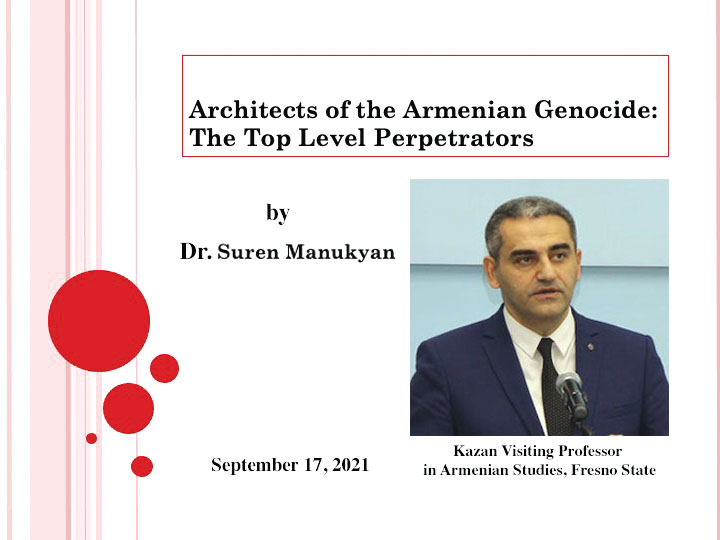
Michael Mazman
Staff Writer
On Friday, September 17, 2021, the Armenian Studies Program hosted Dr. Suren Manukyan, Fresno State’s 18th Kazan Visiting Professor in Armenian Studies, to deliver a lecture titled “Architects of the Armenian Genocide: The Top-Level Perpetrators.” This was the first of a three-part lecture series by Dr. Manukyan on the theme of “Perpetrators of the Armenian Genocide.”
Dr. Manukyan began the discussion by outlining the hierarchy of perpetrators involved in the Armenian Genocide. In order to study a system that has facilitated genocide, it is important to understand the hierarchical relationship between government decision-makers, local public officials, and ordinary private individuals.
Unfortunately, the issue of identifying these offenders remains somewhat outside the academic scope of Armenian Genocide studies. “It has found itself in a perpetual trap of the belief that there is no reason to study a subject as ‘obvious’ as this,” stated Manukyan. For this reason, many perpetrators of the Armenian Genocide were improperly punished, or never punished at all, for their contributions towards an attempt to exterminate the Armenians from the Ottoman Empire.
The top-level decision-makers in the Ottoman government were Dr. Manukyan’s primary focus. They were responsible for formulating the ideology of the Armenian Genocide and supervising the course of the massacres.
These decision-makers often avoided participating in the killings themselves, but rather perpetrated them by supplying legitimization, authorization, and rationalization to their followers in a deliberate attempt to destroy the Armenian people.
Dr. Manukyan affirmed that the state often has a critical role in committing genocide due to its control of the nation’s means of communication and transportation. “State resources, the legitimacy of the use of force, and access to infrastructures make a project as wide-scale as genocide feasible,” noted Dr. Manukyan.
Another major factor to consider is the fact that the state is the only agent with the ability to instill a feeling of hatred towards a victim group in the minds of its population. The Ottomans did this successfully by depicting the Armenian community as evil and a menace to society. Thus, they were able to involve the popular masses of ordinary Ottoman citizens in participating in the act of genocide against the Armenians.
The ruling party in the Ottoman Empire at the time of the Armenian Genocide was the Committee of Union and Progress (CUP), an organization that began planning the destruction of the Ottoman Armenian population in 1910. By 1911, the CUP adopted a policy of Islamization and pan-Turkism across the Ottoman Empire that included efforts to exterminate the Christian populations. In doing so, they elaborated and implemented their plan to destroy the Ottoman Armenians from 1915 to 1923.
In fact, the CUP drafted a document known as the “10 Commandments of the Committee of the Union and Progress” between December of 1914 and January of 1915. “It is a record of the resolutions passed at the secret meetings of the Ottoman Empire’s leading figures,” stated Dr. Manukyan. The document contains several of the disturbing orders that were to be carried out by Ottoman subjects and officials.
Some of these orders include “closing and wiping out all Armenian societies… carrying away the families of those who succeed in escaping to cut them off from all connection… killing off all Armenians in the army… applying measures to exterminate all males under 50…” and were expected to be carried out simultaneously, thus leaving no time for preparation or defensive measures.
Interestingly, this document remained confidential between decision-makers and was only released to the general public in 1919, through its publication in Turkish and Armenian newspapers. By this time, a majority of the massacres had already taken place.
At the conclusion of the lecture, Dr. Manukyan gave his closing remarks and moderator Prof. Barlow Der Mugrdechian conducted the question-and-answer portion of the discussion.
Dr. Manukyan’s analysis of the Ottoman Empire’s top-level perpetrators offered a perceptive background on the origins and ideology of the Armenian Genocide.
Surely, these decision-makers played a crucial part in carrying out these massacres against the Armenian population, even if they were not personally involved in the killings themselves.
They are ultimately the architects of the Armenian Genocide because without their motivation, ordinary local officials and members of the public would have likely been less complicit in carrying out such a great crime against humanity.
 Hye Sharzhoom Armenian Action
Hye Sharzhoom Armenian Action